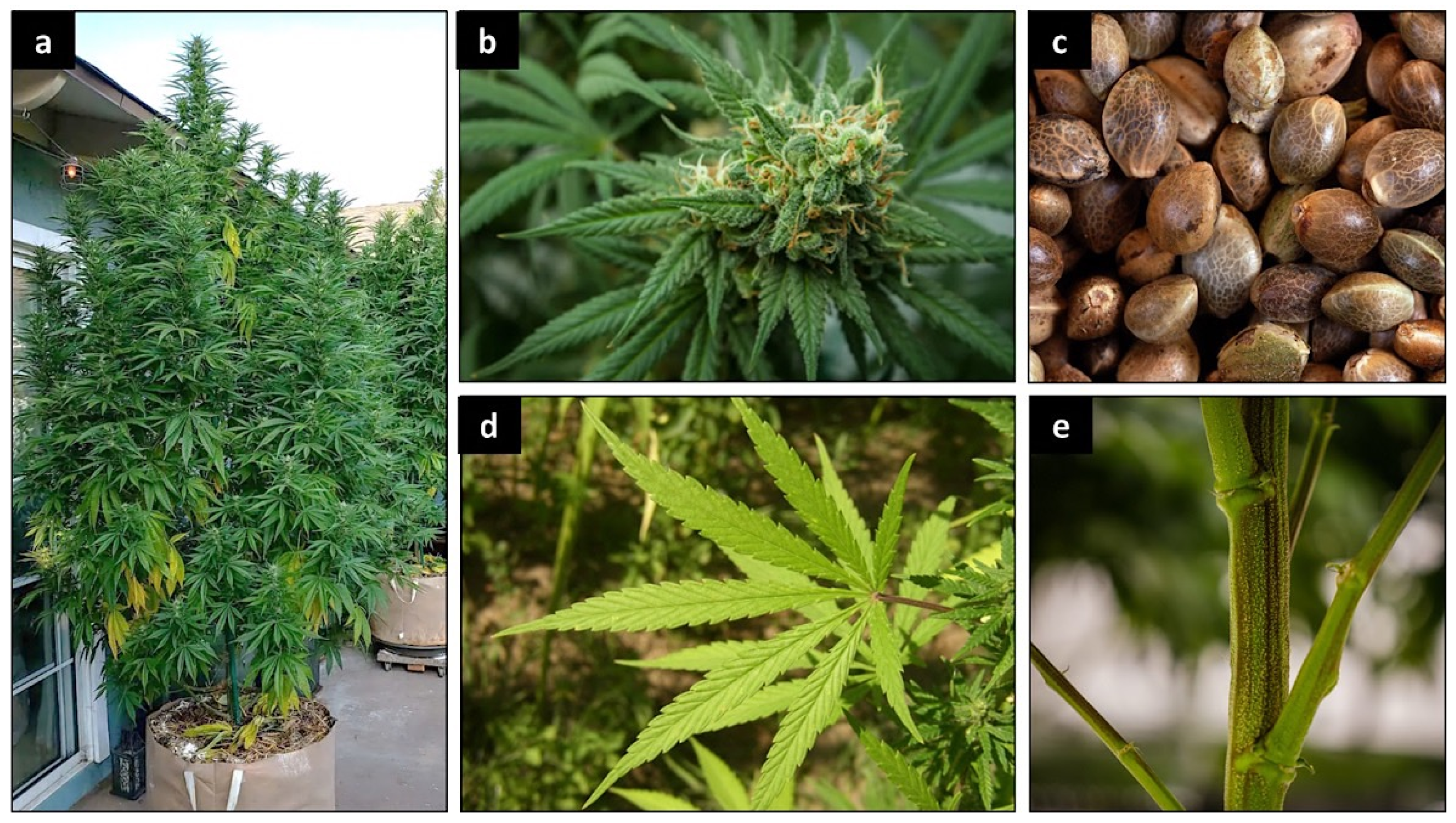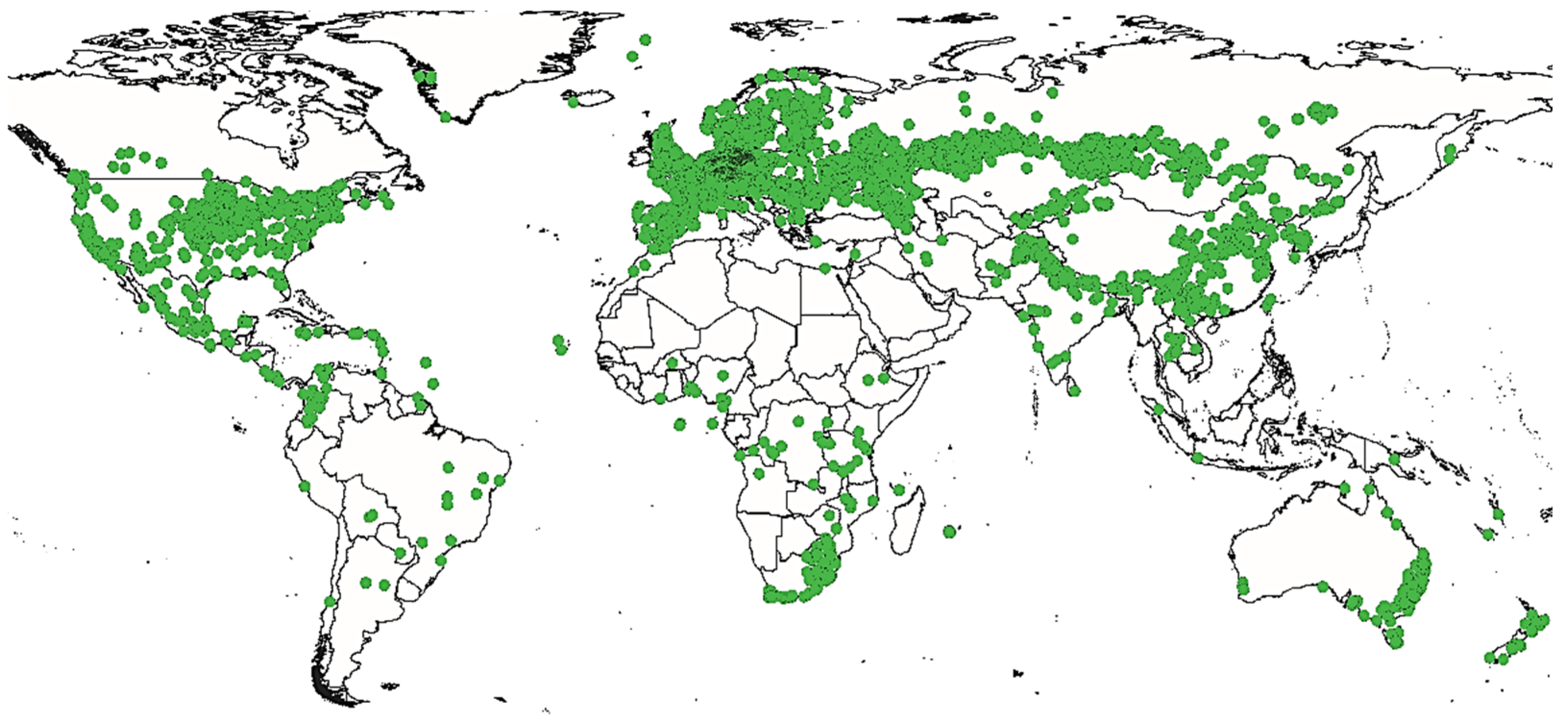
| Version | Summary | Created by | Modification | Content Size | Created at | Operation |
|---|---|---|---|---|---|---|
| 1 | Noureddine EL AOUAD | -- | 1584 | 2023-03-24 12:12:36 | | | |
| 2 | Jessie Wu | Meta information modification | 1584 | 2023-03-27 04:34:34 | | |
Video Upload Options
Cannabis sativa L. is an herbaceous plant belonging to the Cannabaceae family. This plant species has many vernacular names and is known by many people as marijuana and hemp. Despite being native to Central Asia, this plant’s capacity of adaption to different climates lead to its spread all over the world. The Cannabis genus is composed of a single specie named “sativa”, which regroup several subspecies or varieties including Cannabis sativa ssp. sativa, Cannabis sativa ssp. indica, Cannabis sativa ssp. ruderalis and Cannabis sativa ssp. afghanica. However, there is still controversy among the scientific community about the sub-classification of Cannabis species and varieties. Cannabis sativa L. is one of the plants that have been used by humankind since antiquity, and many historians reported the different uses of this plant around the world.
1. Plant Nomenclature and Synonyms
2. Description and Botanical Aspect

3. Geographic Distribution and History

References
- Pollio, A. The name of Cannabis: A short guide for nonbotanists. Cannabis Cannabinoid Res. 2016, 1, 234–238.
- Bruneau, D. Le Cannabis sativa: Une plante psychotrope ayant des intérêtsthérapeutiques. Ph.D. Thesis, University of Rennes, Rennes, France, 2016.
- Russo, E.B. History of cannabis and its preparations in saga, science, and sobriquet. Chem. Biodivers. 2007, 4, 1614–1648.
- Wujastyk, D. Cannabis in Traditional Indian Herbal Medicine; Ayurveda at the Crossroads of Care and Cure, Centro de Historia del Alêmm-Mar, Universidade Nova de Lisboa: Lisbon, Portugal, 2002; pp. 45–73.
- Hazekamp, A. Cannabis Review; Department of Plant Metobolomics, Leiden University: Leiden, The Netherlands, 2008; Volume 2009.
- Farag, S.; Kayser, O. The cannabis plant: Botanical aspects. In Handbook of Cannabis and Related Pathologies; Elsevier: Amsterdam, The Netherlands, 2017; pp. 3–12.
- Anderson, L.C. Leaf variation among Cannabis species from a controlled garden. Bot. Mus. Leafl. Harv. Univ. 1980, 28, 61–69.
- McPartland, J.M. Cannabis systematics at the levels of family, genus, and species. Cannabis Cannabinoid Res. 2018, 3, 203–212.
- McPartland, J.M.; Small, E. A classification of endangered high-THC cannabis (Cannabis sativa subsp. indica) domesticates and their wild relatives. PhytoKeys 2020, 144, 81.
- Schultes, R.E.; Klein, W.M.; Plowman, T.; Lockwood, T.E. Cannabis: An example of taxonomic neglect. In Cannabis and Culture; Rubin, V., Ed.; De Gruyter Mouton: Berlin, NY, USA, 1975; pp. 21–38.
- Pacifico, D.; Miselli, F.; Carboni, A.; Moschella, A.; Mandolino, G. Time course of cannabinoid accumulation and chemotype development during the growth of Cannabis sativa L. Euphytica 2008, 160, 231–240.
- Small, E.; Cronquist, A. A practical and natural taxonomy for Cannabis. Taxon 1976, 25, 405–435.
- Clarke, R.C.; Merlin, M.D.; Small, E. Evolution and classification of Cannabis sativa (Marijuana, Hemp) in relation to human utilization. Bot. Rev. 2015, 81, 189–294.
- Amaducci, S.; Zatta, A.; Raffanini, M.; Venturi, G. Characterisation of hemp (Cannabis sativa L.) roots under different growing conditions. Plant Soil 2008, 313, 227–235.
- Amaducci, S.; Zatta, A.; Pelatti, F.; Venturi, G. Influence of agronomic factors on yield and quality of hemp (Cannabis sativa L.) fibre and implication for an innovative production system. Field Crops Res. 2008, 107, 161–169.
- Campiglia, E.; Radicetti, E.; Mancinelli, R. Plant density and nitrogen fertilization affect agronomic performance of industrial hemp (Cannabis sativa L.) in Mediterranean environment. Ind. Crops Prod. 2017, 100, 246–254.
- Bouloc, P. Le Chanvre Industriel: Production et Utilisations; France Agricole Editions: Paris, France, 2006.
- Anwar, F.; Latif, S.; Ashraf, M. Analytical characterization of hemp (Cannabis sativa) seed oil from different agro-ecological zones of Pakistan. J. Am. Oil Chem. Soc. 2006, 83, 323–329.
- Bouloc, P. Hemp: Industrial Production and Uses; CABI: Wallingford, UK, 2013.
- Schilling, S.; Melzer, R.; McCabe, P.F. Cannabis sativa. Curr. Biol. 2020, 30, R8–R9.
- Lynch, R.C.; Vergara, D.; Tittes, S.; White, K.; Schwartz, C.; Gibbs, M.J.; Ruthenburg, T.C.; DeCesare, K.; Land, D.P.; Kane, N.C. Genomic and chemical diversity in Cannabis. Crit. Rev. Plant Sci. 2016, 35, 349–363.
- Newton, D.E. Marijuana: A Reference Handbook; Abc-Clio: Santa Barbara, CA, USA, 2013.
- Botineau, M. Botanique Systématique et Appliquée des Plantes à Fleurs; Tec & doc: Paris, France, 2010.
- Richard, D.; Senon, J.-L. Le Cannabis; Presses universitaires de France: Paris, France, 2010.
- Strzelczyk, M.; Lochynska, M.; Chudy, M. Systematics and botanical characteristics of industrial hemp Cannabis sativa L. J. Nat. Fibers 2021, 19, 5804–5826.
- Radosevich, S.R.; Holt, J.S.; Ghersa, C. Weed Ecology: Implications for Management; John Wiley & Sons: Hoboken, NJ, USA, 1997.
- Citterio, S.; Santagostino, A.; Fumagalli, P.; Prato, N.; Ranalli, P.; Sgorbati, S. Heavy metal tolerance and accumulation of Cd, Cr and Ni by Cannabis sativa L. Plant Soil 2003, 256, 243–252.
- Magnusson, K.; Svennerstedt, B. Influence of temperature on the water retting process of hemp (Cannabis sativa L.) cultivated under Swedish climate conditions. J. Ind. Hemp 2007, 12, 3–17.
- McPartland, J.M.; Hegman, W.; Long, T. Cannabis in Asia: Its center of origin and early cultivation, based on a synthesis of subfossil pollen and archaeobotanical studies. Veg. Hist. Archaeobot. 2019, 28, 691–702.
- Matthieu, M.L. Les Cannabinoïdes Dans La Prise en Charge des Patients Sous Anticancereux et Antiretroviraux: Connaissances Actuelles et Perspectives D’avenir en France; Faculty of Pharmacy, University of Lille: Lille, France, 2015.
- Li, H.-L. An archaeological and historical account of cannabis in China. Econ. Bot. 1974, 28, 437–448.
- Hill, B. Legalized Marijuana: Canada Comes Round to the Wisdom of Ages, Ancient-Origins. Available online: https://www.ancient-origins.net/history/cannabis-journey-through-ages-003084 (accessed on 6 March 2023).
- Abel, E.L. Marihuana: The First Twelve Thousand Years; Springer Science & Business Media: Berlin, Germany, 2013.
- Ramamoorthy, S.K.; Skrifvars, M.; Persson, A. A review of natural fibers used in biocomposites: Plant, animal and regenerated cellulose fibers. Polym. Rev. 2015, 55, 107–162.
- Turner, C.E.; Elsohly, M.A.; Boeren, E.G. Constituents of Cannabis sativa L. XVII. A review of the natural constituents. J. Nat. Prod. 1980, 43, 169–234.
- Veiga, P. Oncology and Infectious Diseases in Ancient Egypt: The Ebers Papyrus’ Treatise on Tumours 857–877 and the Cases Found in Ancient Egyptian Human Material; University of Manchester: Manchester, UK, 2009.
- Dawson, W.R. Studies in the Egyptian Medical Texts—III. J. Egypt. Archaeol. 1934, 20, 41–46.
- Faulkner, R.O. The Ancient Egyptian Pyramid Texts; Aris & Phillips: Wiltshire, England, 1969.
- Ferrara, M.S. Peak-experience and the entheogenic use of cannabis in world religions. J. Psychedelic Stud. 2021, 4, 179–191.
- Gately, I. Tobacco: A Cultural History of How an Exotic Plant Seduced Civilization; Open Road and Grove Atlantic: New York, NY, USA, 2007.
- Holmes, W.H. Prehistoric Textile Art of Eastern United States; Independently published: Washington, DC, USA, 1896; Volume 13, p. 44.
- Deitch, R. Hemp: American History Revisited: The Plant with a Divided History; Algora Publishing: New York, NY, USA, 2003.
- Chouvy, P.-A. Cannabis cultivation in the world: Heritages, trends and challenges. EchoGéo 2019, 48, 21.




